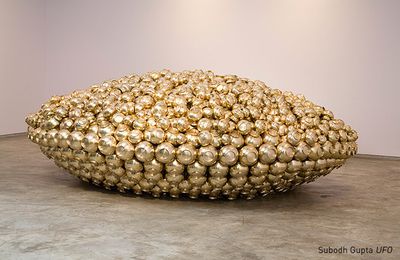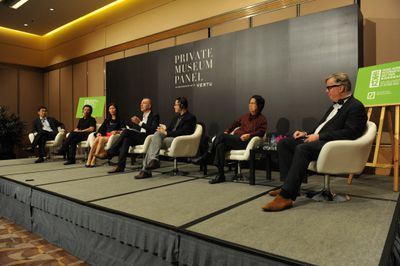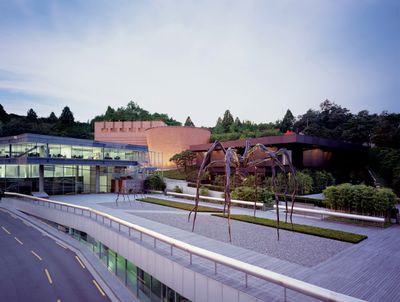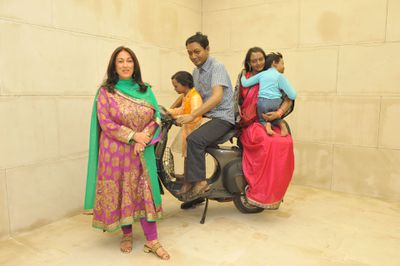17 May 2011
Rethinking Museums | The Art Advisors - Part 1
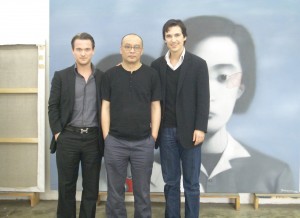
There is a shift occurring in the art world- more and more collectors are setting up their own private art museums in order to share their massive collections with the public. This rising trend, noted especially across India, China and Southeast Asia corresponds to active patronage and private education initiatives which are reinvigorating the local art scene in countries where the lack of gallery or museum infrastructure and government funding has a direct impact on artists and their practice.
[caption id="attachment_10050" align="alignright" width="300" caption="Michael and Nicolai Frahm with Zhang Xiaogang at his studio in Beijing, 2005"]
Much is made of certain private individuals who reportedly go on buying sprees at art fairs and auctions; much is reported on their private museums which cost millions to build in order to house their massive collections- But what of their unheralded Art Advisor who discreetly guides the spending hand of the collector, the “taste maker” of these individuals?
From building substantial art collections to building private museums, renowned Art Advisors Nicolai and Michael Frahm, widely regarded as one of the art world's best, have expanded their roles to the extent which now includes everything from aquisitions to shortlisting architects to strategizing the curatorial and educational framework for such “Private Museums” across the globe. In this two part interview, Bharti Lalwani has an indepth and open conversation with the brothers in London, about the nature of art advisory which, more often than not, goes undiscussed in the larger context of the private museum phenomena.
(Key- NF: Nicolai, MF: Michael, B: Bharti)
Part 1
B: Let's start with how you got involved with the arts, I understand your father – Flemming Frahm, was a collector and in fact had an art foundation in Copenhagen many years back.
MF: Yes, our father began collecting contemporary art in the 70s. He ran a successful family business and art was his greatest passion. He was a collector in the true sense- obsessed with the idea of building something from scratch and watching it grow bigger and stronger. He was also a collector of wine, furniture, books and watches among other things but the main part of his collection was post-war European abstract paintings with a heavy emphasis on CoBrA art. From that movement, there was a specific focus on not just artists such as Asger Jorn, Carl-Henning Pedersen, Karel Appel, Pierre Alechinsky but also on other abstract artists from the same period- Pierre Soulages and Lucio Fontana. Flemming was a well educated collector with a great knowledge about the artists he collected and had a broad understanding of art history.
B: But did he have an art adviser to begin with?
MF: Actually, he worked closely on the collection with Borge Birch, who was his personal advisor and a close friend. Borge advised on all critical aspects of the collection. He was a well known figure on the international art scene and founded the first contemporary art gallery in Denmark in 1946. He is broadly recognised for his work with the CoBrA movement as well as for representing artists such as Asger Jorn and Guillaume Cornelis. Borge essentially became Flemming’s art-market agent, expert and coach, he very much filled the same role as we do today for the collections we work with.
NF: Our dad always had a bigger vision concerning his collection- he had a strong desire to share his love and passion for art with others. This was accomplished through the family foundation in Copenhagen- Galerie Frahm, which opened to the public in the mid 90s. That same vision is something we both share as brothers today, and we envision opening our own foundation or museum some day only this time probably in London.
B: Nicolai, I understand you made the career choice very early on when you moved to London to do the MA (at Sotheby's Institute) in Post-war and Contemporary Art.
[caption id="attachment_10088" align="alignright" width="300" caption="Art Advisors Nicolai and Michael Frahm"]
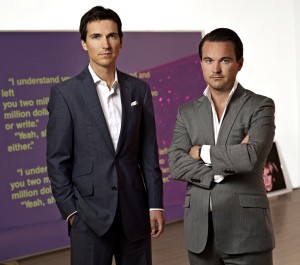 [/caption]
[/caption]NF: Yes in fact I moved to London shortly after our family foundation opened in Copenhagen and that was around the same time when Charles Saatchi put together his Sensation exhibition of the then YBA's (Young British Artist) at The Royal Academy in 1997. The art at Sensation was tough, in-your-face and something completely new and different from the art we had grown up with. It was being created in the now and felt like art history in the making. I became fascinated with the idea of the “super collector” and knew then and there that I wanted to make collecting my life. We then started buying works by artists such as Damien Hirst, Tracy Emin, Abigail Lane, Sam Taylor Wood and Chris Ofili.
B: So after completeing your MA you built your experience through working with the Nahmads, and then as a specialist at Christies auction house...How did that come about?
NF: Actually I first met Helly Nahmad at a Christie’s auction in London in 1997. It was the first auction where Christie’s had decided to divide their Contemporary sales into Post-War art (works from 1945 to 1970) and Contemporary Art (works from 1970 to current) and it was also the first time younger artists, especially the YBA’s, were featured on auction. After the impact of Saatchi’s Sensation exhibition we decided to expand our family collection in Copenhagen and start acquiring such current art and this auction was the perfect place to begin as it had major works by Damien Hirst, Chris Ofili, Rachel Whiteread, Jake & Dinos Chapman amongst others.
As the auction progressed, a young man sitting on the front row, kept outbidding us on most of the works we wanted! Another man seated beside me said “forget about it! That's Helly Nahmad, his family has unlimited funds.” The Nahmads turned out to be the largest Impressionist and Modern art dealers in the world based out of London, New York and Monaco. After the auction I went up to Helly and expressed my despair at being outbid by him and he then asked me to come to his gallery, which had opened only a month earlier on Cork Street with an exhibition of major paintings by Picasso, Monet, Kandinsky, Mondigliani and Cezanne.
After that incident we quickly became friends, Helly being only 21 and I was 22 at the time. As he had recently developed a taste for contemporary art, he asked me to join his gallery to run the contemporary department.
Only a year thereafter, Christie’s approached me to join their contemporary art department in London as one of their four specialists (and I was the youngest specialist so far). Having been fascinated with auctions since I was young, it was like a dream come true. Here I got to meet and learn about all the major collectors, dealers, advisors, museum curators and critics, and got to know all the ins and outs of the art business and all that happened behind the scenes. But most crucially, I amassed an incredible knowledge about the whereabouts of works by all major artists; I took joy in knowing which collectors owned what.
B: And thats how you figured that collecting was perhaps your passion and you wanted to persue this full out
NF: Definitely! I not only wanted to collect but also to build major collections and with that in mind I opened an office in Mayfair (London) and much later, another one in Basel.
B: And your first major client was Frank Cohen
NF: Yes, Frank has been a collector for the last 30 years of Modern British art, at the time we met, Frank had only just gotten into collecting contemporary. We became quite inseparable and we have been building and curating his collection ever since along with setting up and running his art foundation Initial Access in Wolverhampton. We share an incredible passion for promoting new and often underrated artists and for finding the next major stars.
While Frank’s contemporary collection started out with upcoming artists, it now includes major works from the 70s, 80s, 90s and 2000s from around the world, with artists such as Lee Ufan, Jeff Koons, Richard Prince, Christopher Wool, Takashi Murakami, Andreas Gursky, Zeng Fanzhi and Ai Weiwei. Since starting with Frank, we have taken on a roster of some of the world’s biggest contemporary art collectors, building and curating their collections and eventually setting up their own foundations and museums.
B: You mentioned Chinese artist/ activist Ai Weiwei and the sublime Korean artist Lee Ufan, so obviously as advisors you must have to look at art and artists beyond the usual parametres of Europe and the States...
MF: We live and breathe art and we travel around the globe for it. Just last year, both Nicolai and I spent more than 250 days traveling to different cities aroud the globe, which means we got to see and experience quite a huge amount and variety of work. Last year alone we visited fairs, artists' studios, museums, galleries and collectors in Moscow, Zurich, Sao Paulo, Singapore, Taipei, Gwangju, Beijing, Shanghai, Hong Kong, Abu Dhabi, Dubai, Berlin, Mexico City, Madrid, Delhi, Mumbai, Basel, Miami, Rio, Jakarta, Tokyo, Istanbul, New York, LA, Copenhagen, Cologne, Munich, Lisbon and Athens!
The art world has changed dramatically from the generation before us in the sense that the major focus used to be on artists based in US and Europe, now collectors and gallerists from around the world engage with artists in any country around the world. The local scene has become a global one. We try to split the map between us to optimize time and look at as much as possible. We are rarely in the same place at the same time, which gives us an edge. This is probably the most important aspect of what we do. The Internet has of course made it much more accessible to view art works from all over the world, but you still cannot beat the experience of physically seeing the works installed in galleries, museums, or especially experiencing the process and chaos in the artists’ studios itself.
We have been extremely passionate about Chinese art right from our first trip to Beijing and Shanghai in the early 2000s. It was long before others in the business even considered China as a place for contemporary art. Beijing was especially fascinating and the art felt like a breath of fresh air. We found the art to be exceptionally strong with a distinct Chinese voice, and to our great joy, painting was the preferred medium. It was like discovering a whole new world of unexplored ideas, subject matter and technique. Although the inspiration often came from Western artist such as Rauschenberg, Warhol and Richter, there was a special energy and atmosphere here, almost like New York in the 1960’s. It was also the time when many artists who had been educated or living overseas for years started returning home to China with new perspectives.
B: Well, many artists from China and elsewhere have been widely overlooked for the larger part...
MF: Yes, even though the international exhibition ‘Magiciens de la Terra’ at the Centre Pomipidou in 1983 included Huang Yongping, Gu Dexin and Yang Jiechang and the 45th edition of the Venice Biennale in 1993 included Fang Lijun, Xu Bing, Wang Guangyi and Liu Wei amongst others most Chinese artists still certainly felt overlooked. In the 1990’s you certainly were still not seeing Chinese artists at major European or American galleries and there were not any significant galleries within China until the late 90’s. We always felt strongly about promoting the most promising Chinese artists internationally and try to get them the global recognition that we felt they deserved. Unlike the trend at the time, our idea was never to label the art as ‘Made in China’, we always felt that the works were strong enough to sit next to greatest artists from the West, and we wanted to integrate the art rather then labeling it.
B: And how was that accomplished?
NF: In 2007 we put together an exhibition called ‘Time Difference’ at Frank Cohen’s Initial Access, which was an exhibition of paintings from China and sculptures from America. It was the first time some of these major Chinese artists had been shown in the UK. The following year Charles Saatchi opened his new space in London with his inaugural exhibition being on Chinese contemporary art titled ‘The Revolution Continues’. With more then 400,000 visitors in 3 months it became the most visited exhibition in London in 2009]. China had finally arrived on the British scene!
Bharti Lalwani has a BA in Fine Art and an MA in Contemporary Art; She writes for several publications across SE Asia and India.
Similar content
posted on
16 Aug 2011
posted on
20 May 2011
posted on
15 Jan 2011
posted on
25 Jun 2012
posted on
10 Feb 2011
posted on
11 Apr 2011


